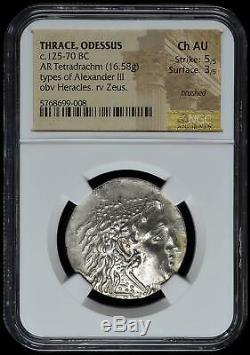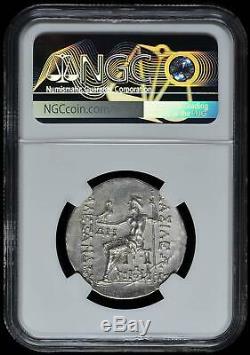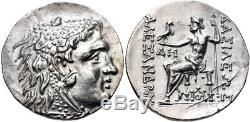Thrace Odessus AR Tetradrachm 125-70 BC NGC Ch AU 5/4 Alexander III Bright Coin





Thrace Odessus, AR Tetradrachm [29.5mm, 16.56 g, 12h] in the name and types of Alexander III of Macedon. Head of Herakles [Hercules] right, wearing lion skin / Zeus Aëtophoros seated left; H in left field, OH (civic) monogram below throne.
Callataÿ Group 1; Topalov, Odesos , Series 31, Issue 67; Price 1180; HGC 3, 1587. Graded NGC Choice AU 5/4. Sharp strike, bold white metal with incredible luster. Long die break on reverse with faint brushing.
Odessus [Odessos] is the modern city of Varna. Varna (Bulgarian: , pronounced [varn]) is the third largest city in Bulgaria and the largest city and seaside resort on the Bulgarian Black Sea Coast. Situated strategically in the Gulf of Varna, the city has been a major economic, social and cultural centre for almost three millennia. Varna, historically known as Odessos (Ancient Greek:), grew from a Thracian seaside settlement to a major seaport on the Black Sea. Varna is an important centre for business, transportation, education, tourism, entertainment and healthcare. The city is referred to as the maritime capital of Bulgaria and headquarters the Bulgarian Navy and merchant marine. In 2008, Varna was designated seat of the Black Sea Euroregion by the Council of Europe. In 2014, Varna was awarded the title of European Youth Capital 2017. The oldest gold treasure in the world, belonging to the Varna culture, was discovered in the Varna Necropolis and dates to 42004600 BC. Prehistoric settlements best known for the Chalcolithic necropolis (mid-5th millennium BC radiocarbon dating), a key archaeological site in world prehistory, eponymous Varna culture and internationally considered the world's oldest large find of gold artifacts, existed within modern city limits. In the wider region of the Varna lakes (before the 1900s, freshwater) and the adjacent karst springs and caves, over 30 prehistoric settlements have been unearthed with the earliest artefacts dating back to the Middle Paleolithic or 100,000 years ago. Thracians Since late Bronze Age 13th12th c.BC the area around Odessos had been populated with Thracians. BC local Thracians had active commercial and cultural contacts with people from Anatolia, Thessaly, Caucasus and the Mediterranean Sea. These links were reflected in some local productions, for example, forms of bronze fibula of the age, either imported or locally made. There is no doubt that interactions occurred mostly by sea and the bay of Odessos is one of the places where the exchanges took place. Some scholars consider that during the 1st millennium BC, the region was also settled by the half-mythical Cimmerians.
An example of their, probably accidental, presence, is the tumulus dated 8th7th c. BC found near Belogradets, Varna Province. The region around Odessos was densely populated with Thracians long before the coming of the Greeks on the west seashore of the Black Sea. Around the city [Odessos] lives the Thracian tribe named Crobises.This is also evidenced by various ceramic pottery, made by hand or by a Potter's wheel, bronze ornaments for horse-fittings and iron weapons, all found in Thracian necropolises dated 6th4th c. BC near the villages of Dobrina, Kipra, Brestak and other, all in Varna Province. The Thracians in the region were ruled by kings, who entered into unions with the Odrysian kingdom, Getae or Sapaeanslarge Thracian states existing between 5th1st c. Between 336280 BC these Thracian states along with Odessos were conquered by Alexander the Great. Archaeological findings have indicated that the population of northeast Thrace was very diverse, including the region around Odessos.
BC the region was populated with Scythians who normally inhabited the central Eurasian Steppe (South Russia and Ukraine) and partly the area south of river Istros (the Thracian name of lower Danube). Characteristic for their culture weapons and bronze objects are found all over the region.
Scythian horse ornaments are produced in animal style, which is very close to the Thracian style, a possible explanation for the frequent mixture of both folks in northeastern Thrace. Many bronze artefacts give testimony for such process, for example, applications and front plates for horse heads, as well as moulds for such products in nearby and more distanced settlements.BC the region had been populated by more Getae, which is a Thracian tribe populating both shores around the Danube Delta. Celts started populating the region after their invasion of the Balkan peninsula in 280 BC. All over northeast Bulgaria and even near Odessos were found a significant number of bronze items with Celtic ornaments and typical weapons, all quickly adopted by Thracians. Arkovna, 80 km near Odessos, was probably the permanent capital of Celts' last king Kavar (270/260216/210 BC).
Probably after the downfall of his kingdom, Celts blended with the greatly numbered Thracians in the country. BC in present Dobrudja land between Dyonissopolis (Balchik) and Odessos were created many small Scythian states. Their kings minted their coins in mints located in cities on the west Black Sea coast, including Odessos. The Thracians in northeast Thrace seem to be underdeveloped compared to their counterparts in South Thrace.The people lived in two types of settlements: non-fortified, located in fertile lands near water sources and stone built fortresses in hard to reach mountain environment, where were usually located the kings' residences. Thracians engaged in farming, wood processing, hunting and fishing.
Among their art crafts is metal processingespecially weapons, excelling processing of bronze, making of bracelets, rings, Thracian type of fibulas, horse ornaments, arrowheads. Local goldsmiths used gold and silver to produce typical Thracian plate armour, ceremonial ornaments for the horses of the kings and the aristocracy, as well as valuable pateras and ritons.
Despite ethnic diversity, numerous internal and external conflicts, and cultural differences, the populations of northeastern Bulgaria and the cities along the seashore have demonstrated stable tolerance to each other. Conservatism is easily noticed in ceramic items and in religion.The highest deity of all was the Thracian horseman, who had different names and functions in different places. Water-related deities were honoured as well, such as The Three Graces or the water Nymphs and Zalmoxis by the Getae. During the centuries, especially by the end of the Hellenistic period 2nd1st c. BC, Thracians adopted the more elaborated Hellenistic culture, thus acting as an intermediate for the continental Thracians. Odessos or Odessus (Ancient Greek:) is one of the oldest ancient settlements in Bulgaria.
Its name appears as Odesopolis in the Periplus of Pseudo-Scylax; and as Odyssos or Odyssus in the Synecdemus and in Procopius. It was established in the second quarter of the sixth century BC (585550 BC) by Miletian Greeks at a present at that time Thracian settlement. The Miletian founded an apoikia (trading post) of Odessos towards the end of the 7th c. BC (the earliest Greek archaeological material is dated 600575 BC), or, according to Pseudo-Scymnus, in the time of Astyages (here, usually 572570 BC is suggested), within an earlier Thracian settlement.The name Odessos could have been pre-Greek, arguably of Carian origin. It was the presiding member of the Pontic Pentapolis, consisting of Odessos, Tomi, Callatis, Mesembria, and Apollonia. Odessos was a mixed communitycontact zone between the Ionian Greeks and the Thracian tribes (Getae, Krobyzoi, Terizi) of the hinterland. Excavations at nearby Thracian sites have shown uninterrupted occupation from the 7th to the 4th century BC and close commercial relations with the colony.
The Greek alphabet has been applied to inscriptions in Thracian since at least the 5th century BC. See also: Derzelas Odessos was included in the assessment of the Delian league of 425 BC. In 339 BC, it was unsuccessfully besieged by Philip II (priests of the Getae persuaded him to conclude a treaty) but surrendered to Alexander the Great in 335 BC, and was later ruled by his diadochus Lysimachus, against whom it rebelled in 313 BC as part of a coalition with other Pontic cities and the Getae. Nevertheless, at the end of the 4th c.
BC the city became one of the strongholds of Lysimachus. The city became very prosperous from this time due to stong sea trade with many of the Mediterranean states and cities supported by a wide range of local products. Shortly after 108 BC, Odessos recognised the suzerainty of Mithridates VI of Pontus. The Roman city, Odessus, first included into the Praefectura orae maritimae and then in 15 AD annexed to the province of Moesia (later Moesia Inferior), covered 47 hectares in present-day central Varna and had prominent public baths, Thermae, erected in the late 2nd century AD so called Large (North) Ancient Roman Thermae, now the largest Roman remains in Bulgaria the building was 100 m (328.08 ft) wide, 70 m (229.66 ft) long, and 25 m (82.02 ft) high and fourth-largest-known Roman baths in Europe which testify to the importance of the city.
There is also the Small (South) Ancient Roman Thermae from the 5th-6th century AD. In addition, archaeologists in 2019 discovered ruins of a building of Roman thermae from the 5th century AD. Major athletic games were held every five years, possibly attended by Gordian III in 238. The main aqueduct of Odessos was recently discovered during rescue excavations north of the defensive wall.
The aqueduct was built in three construction periods between the 4th and the 6th centuries; in the 4th century the aqueduct was built together with the city wall, then at the end of the 4th to early 5th centuries when a pipeline was laid inside the initial masonry aqueduct. Thirdly in the 6th century an extra pipeline was added parallel to the original west of it and entered the city through a reconstruction of the fortress wall. The city minted coins, both as an autonomous polis and under the Roman Empire from Trajan to Salonina, the wife of Gallienus, some of which survive. Odessos was an early Christian centre, as testified by ruins of twelve early basilicas, a monophysite monastery, and indications that one of the Seventy Disciples, Ampliatus, follower of Saint Andrew (who, according to the Bulgarian Orthodox Church legend, preached in the city in 56 CE), served as bishop there.
In 6th-century imperial documents, it was referred to as "holiest city, " sacratissima civitas. In 442 a peace treaty between Theodosius II and Attila was conducted at Odessos. In 513, it became a focal point of the Vitalian revolt. In 536, Justinian I made it the seat of the Quaestura exercitus ruled by a prefect of Scythia or quaestor Justinianus and including Lower Moesia, Scythia, Caria, the Aegean Islands and Cyprus; later, the military camp outside Odessos was the seat of another senior Roman commander, magister militum per Thracias. Bulgarian conquest It has been suggested that the 681 AD peace treaty with the Byzantine Empire that established the new Bulgarian state was concluded at Varna and the first Bulgarian capital south of the Danube may have been provisionally located in its vicinitypossibly in an ancient city near Lake Varna's north shore named Theodorias by Justinian Ibefore it moved to Pliska 70 kilometres (43 miles) to the west.
Asparukh fortified the Varna river lowland by a rampart against a possible Byzantine landing; the Asparuhov val (Asparukh's Wall) is still standing. Numerous 7th-century Bulgar settlements have been excavated across the city and further west; the Varna lakes north shores, of all regions, were arguably most densely populated by Bulgars. It has been suggested that Asparukh was aware of the importance of the Roman military camp (campus tribunalis) established by Justinian I outside Odessos and considered it (or its remnants) as the legitimate seat of power for both Lower Moesia and Scythia. The item "Thrace Odessus AR Tetradrachm 125-70 BC NGC Ch AU 5/4 Alexander III Bright Coin" is in sale since Sunday, April 5, 2020. This item is in the category "Coins & Paper Money\Coins\ Ancient\Greek (450 BC-100 AD)".The seller is "appreciatingobjects" and is located in Hampton, New Hampshire. This item can be shipped worldwide.
- Cleaned/Uncleaned: Uncleaned
- Modified Item: No
- Country/Region of Manufacture: Bulgaria
- Certification: NGC
- Date: 125 BC
- Grade: Ch AU 54
- Composition: Silver
- Denomination: Tetradrachm


